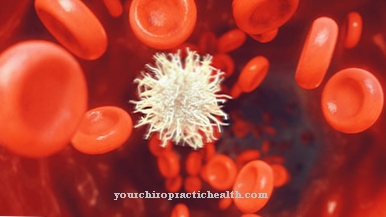The Chorioretinitis is a serious inflammation of the fundus that can have many causes. Without drug treatment, there is a risk of permanent visual impairment. In the worst case, blindness occurs as a result of chorioretinitis.
What is chorioretinitis?

© GraphicsRF - stock.adobe.com
Chorioretinitis is an inflammation of the retina (retina) and choroid (choroid) of the eye. The retina consists of light-sensitive sensory cells and the dissipating nerve cells.
The choroid, with its intensive blood supply, supplies the tissue of the retina with nutrients and oxygen. The close connection between the retina and choroid almost always leads to a joint infestation of both tissue layers in inflammatory processes in the eye. The foci of inflammation appear as bright, yellowish-white spots mostly scattered (chorioretinitis disseminata).
An infection over the entire surface of the retina and choroid is rarely observed, as is an isolated inflammation of the “yellow spot” (central chorioretinitis). This middle region of the retina is the location of the highest optical resolution.
The chorioretinitis can also affect the point of entry of the optic nerve (chorioretinitis juxtapapillaris). Precipitation of proteins in the vitreous humor of the eyeball is a general side effect of chorioretinitis.
causes
Chorioretinitis is a condition that can have many infectious triggers. Bacteria and viruses are possible pathogens as well as mycoses (fungal attack). Therefore, the disease often occurs as a result of other infections.
Herpes, Lyme disease, rubella or syphilis are some of the most common pre-existing conditions of chorioretinitis. Typically, the patients also include many HIV-infected people who have already developed AIDS. After all, blood poisoning always carries the risk of chorioretinitis.
In some cases, even single-celled animal parasites cause the dangerous inflammation of the fundus (toxoplasmosis). Occasionally, autoimmune reactions also cause chorioretinitis. In this variant, the immune system attacks the body's own substances in the retina and choroid. In this case, the doctor speaks of rheumatic chorioretinitis.
You can find your medication here
➔ Medicines for visual disturbances and eye complaintsSymptoms, ailments & signs
In the worst case, chorioretinitis can lead to permanent visual disturbances or even to complete blindness of the patient. However, this only occurs if the condition is not treated. The chorioretinitis primarily leads to severe inflammation of the eye.
Not only does the retina become inflamed, but also the patient's choroid. This results in pain in the eye and, in many cases, visual disturbances, which can have a very negative effect on the patient's quality of life. If the chorioretinitis is ignored, the result is complete blindness, which can no longer be treated and is therefore irreversible.
Bleeding can occur on the vitreous itself, which can also lead to visual problems. Those affected mainly suffer from blurred vision or double vision. With severe visual problems, those affected may need help from other people in their everyday lives.
Likewise, chorioretinitis can also lead to psychological complaints. These mainly occur if the chorioretinitis is not treated and there is permanent damage to the eye. Young people in particular are affected by the psychological complaints.
Diagnosis & course
The doctor diagnoses chorioretinitis during the ophthalmoscopic examination. So the doctor looks in the eye with the slit lamp microscope and looks for opacities in the vitreous humor that justify the suspicion of chorioretinitis. Clear indications are the bright, bulging inflammation centers in the fundus. Imaging procedures with contrast media provide further evidence of chorioretinitis.
Often times, chorioretinitis is diagnosed too late because there are no symptoms in the early stages of the disease. The patient only notices visual disturbances when the yellow spot is attacked or at an advanced stage. If the field of vision has already been restricted, there is a risk of permanent visual impairment.
With a milder course, the opacities in the vitreous body can disappear. Smaller scarring in the retina does not necessarily have to lead to impaired vision. The early treatment of chorioretinitis is often decisive for the favorable course.
Complications
Chorioretinitis can cause complications in the eye. It usually leads to visual defects if left untreated. In the worst case scenario, there is a complete loss of vision and thus blindness. By reducing eyesight, the patient's quality of life is reduced.
In most cases, however, there is no pain with chorioretinitis. The affected person complains of blurred vision and cloudiness in the eyes. The visual defects can also lead to headaches and impaired concentration. Secretions also form in the affected areas. In most cases, treatment is possible and it is successful relatively quickly.
It is usually carried out with the help of antibiotics and does not lead to any further complications or complaints. It is only important that the patient starts treatment at an early stage. Eye drops or syringes can also be used in severe cases. The chorioretinitis does not lead to a reduced lifespan.
Only in the case of serious infections does a significant loss of vision or complete blindness occur. In these cases, the patient is dependent on various aids in order to cope with everyday life.
When should you go to the doctor?
In the event of impairment of vision and visible redness of the eyes, a doctor should be consulted quickly. If left untreated, chorioretinitis can lead to blindness and must therefore be clarified. Medical advice is required at the latest when the visual disturbances widen, for example blurred vision or cloudiness in the eyes. Herpes, borreliosis, rubella and syphilis are typical pre-existing conditions of chorioretinitis.
Even people infected with HIV who have already had the AIDS virus and people with blood poisoning often develop eye infections. The following applies to these risk groups: speak to the responsible doctor in the event of redness, visual disturbances or other unusual symptoms. If visual problems develop as part of an autoimmune disease, rheumatic chorioretinitis may be present, which must also be clarified and treated.
In any case, the sick person should consult their ophthalmologist regularly to rule out complications.If permanent visual disturbances or complete blindness have already set in, psychological help may also be useful.
Doctors & therapists in your area
Treatment & Therapy
Chorioretinitis requires rapid intervention against the inflammation. Cortisone preparations are the first choice for all forms of the disease.
Once the doctor has identified a certain pathogen as the cause, he will prescribe a specific antidote. These are then either antibiotics or antivirals and, if necessary, antimycotics. The medication is given as eye drops or injected directly into the eyeball through the conjunctiva. This is how the pharmaceuticals optimally reach their site of action.
Oral dosage forms should have a "systemic" effect, i.e. via the path of the organism with its blood circulation. Laser treatment is indicated for severe damage to the retina. This can help to avert permanent visual impairment or to keep it within limits. Because a detachment of the retina is also a possible consequence of chorioretinitis.
Outlook & forecast
In most cases, chorioretinitis can be treated relatively well. Serious complaints and complications can only arise without treatment. If the disease is not treated, it can lead to permanent visual problems and in the worst case to complete blindness. This is still not reversible and cannot be treated.
Patients with chorioretinitis suffer from inflammation of the eye, which is accompanied by visual disturbances. The vitreous humor appears cloudy, which also has a negative effect on the eyesight of the person affected. In some cases, chorioretinitis can also scar the retina, although this does not always lead to visual problems.
Treatment of chorioretinitis proceeds without complications and is carried out with the help of eye drops. This completely alleviates the discomfort. With early treatment, they disappear completely and there is no permanent damage. In the case of severe damage to the retina, laser surgery can also take place, which can alleviate the visual problems.
Regular checkups at the ophthalmologist can prevent chorioretinitis. It does not have a negative effect on the quality of life of the person concerned.
You can find your medication here
➔ Medicines for visual disturbances and eye complaintsprevention
Due to its diverse triggers, chorioretinitis is very difficult to prevent with individual measures. Risk patients should take part in preventive examinations at an ophthalmologist. This is an option for people who have experienced one of the relevant infectious diseases (see above).
People from families with frequent rheumatism also belong to the endangered segment of the population. Such controls are particularly advisable for people infected with HIV. Likewise, people who have to take medication to reduce immune reactions (immunosuppressants) should consult their ophthalmologist regularly. Early detection is the best way to fight chorioretinitis.
Aftercare
In the case of chorioretinitis, there are usually no special follow-up measures available to those affected. The patient should consult a doctor at the first symptoms and signs of the disease so that there are no further complications or a further worsening of the symptoms. If the chorioretinitis is not treated, in the worst case it can even lead to complete blindness, which is no longer reversible.
Usually the condition is treated by taking medication and eye drops. The person concerned should always ensure correct and regular intake so that the symptoms can be alleviated. It should also be noted that alcohol should not be taken with these drugs. However, if this treatment for chorioretinitis is not effective, laser surgery must be performed.
However, the disease cannot be completely cured by this, so that the person affected is still dependent on visual aids afterwards. These should be worn regularly so that the eye muscles are not unnecessarily strained. Since chorioretinitis can lead to blindness, psychological treatment should also be carried out so that depression or mental disorders do not occur. However, the life expectancy of the patient is not reduced by the disease.
You can do that yourself
For patients with chorioretinitis, an immediate doctor's visit is necessary to avoid permanent damage to the visual function. If treatment for chorioretinitis is missed or started too late, people may have lifelong vision problems.
Therefore, the chorioretinitis cannot be treated independently, but can be treated by an ophthalmologist. In order to support the medical treatment of the eye disease in the best possible way, the patients take a break for a few days in order to give the inflamed eyes the opportunity to regenerate.
Treatment for chorioretinitis is often given by an injection into the eye. While the eye is to be spared before the procedure, this principle applies in particular to the time after the treatment. Under no circumstances are patients allowed to drive themselves after therapy. Instead, patients remain as passive as possible for the rest of the day and do not strain their eyes.
Therefore, it is forbidden for those affected to watch television or computer screens at home. At best, patients sleep as much as possible and forego physical activity. In order to restore the visual function, it makes sense to leave the job for a few days and to make it easier for the eyes to regenerate.




.jpg)






















